Solved: Criminal Law Assignment
VerifiedAdded on 2021/02/21
|13
|4717
|18
AI Summary
Contribute Materials
Your contribution can guide someone’s learning journey. Share your
documents today.
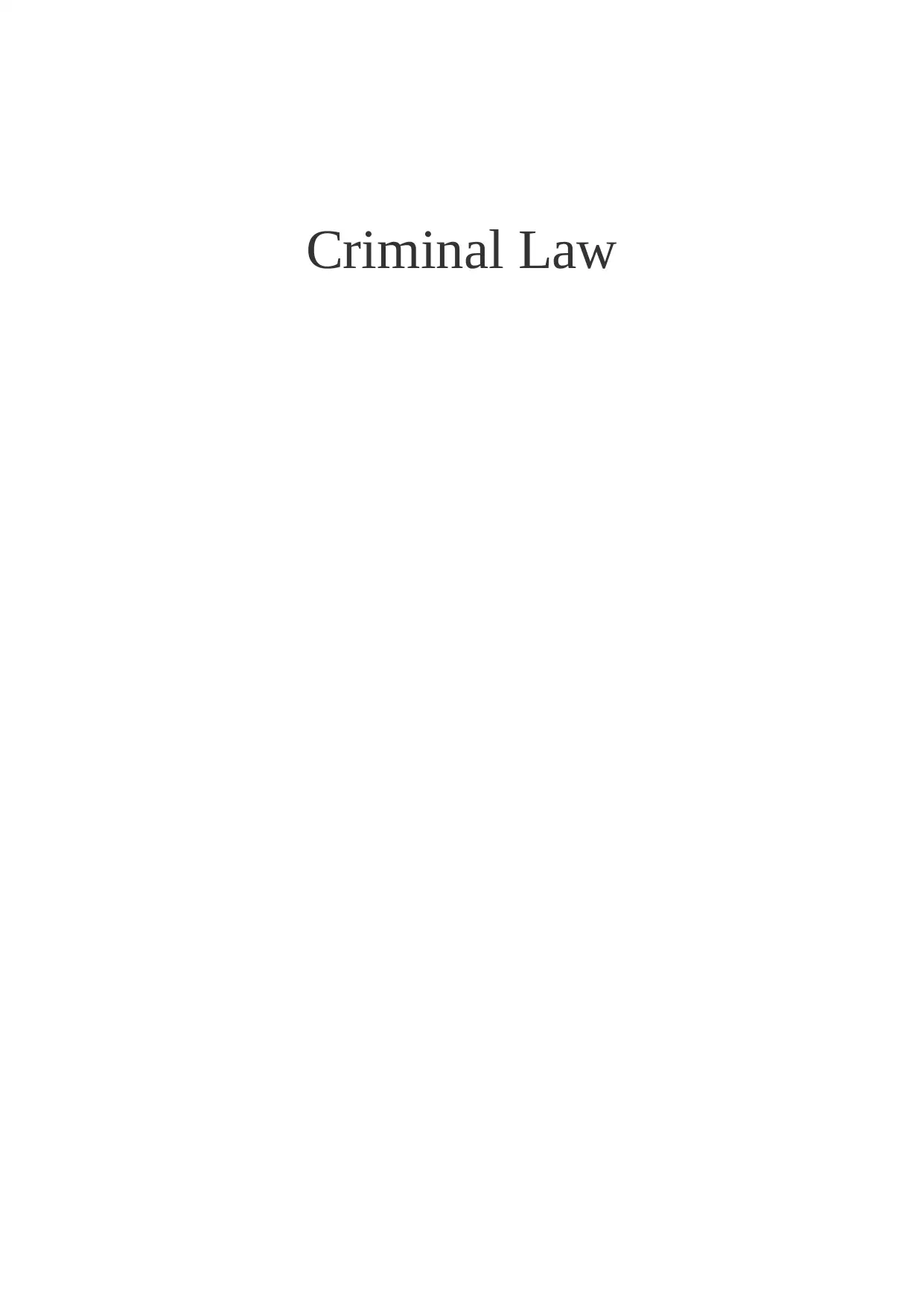
Criminal Law
Secure Best Marks with AI Grader
Need help grading? Try our AI Grader for instant feedback on your assignments.
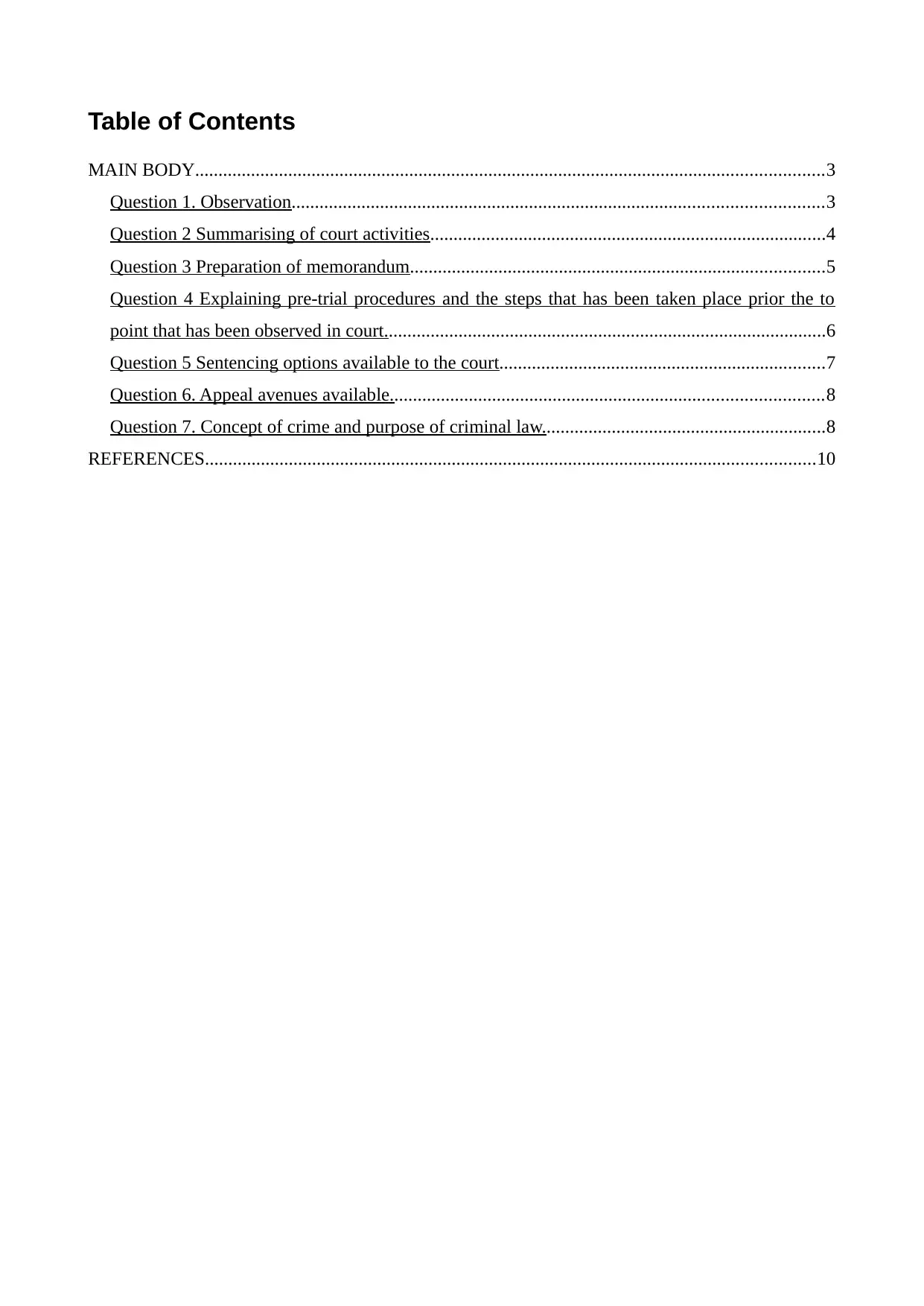
Table of Contents
MAIN BODY.......................................................................................................................................3
Question 1. Observation..................................................................................................................3
Question 2 Summarising of court activities.....................................................................................4
Question 3 Preparation of memorandum.........................................................................................5
Question 4 Explaining pre-trial procedures and the steps that has been taken place prior the to
point that has been observed in court...............................................................................................6
Question 5 Sentencing options available to the court......................................................................7
Question 6. Appeal avenues available.............................................................................................8
Question 7. Concept of crime and purpose of criminal law.............................................................8
REFERENCES...................................................................................................................................10
MAIN BODY.......................................................................................................................................3
Question 1. Observation..................................................................................................................3
Question 2 Summarising of court activities.....................................................................................4
Question 3 Preparation of memorandum.........................................................................................5
Question 4 Explaining pre-trial procedures and the steps that has been taken place prior the to
point that has been observed in court...............................................................................................6
Question 5 Sentencing options available to the court......................................................................7
Question 6. Appeal avenues available.............................................................................................8
Question 7. Concept of crime and purpose of criminal law.............................................................8
REFERENCES...................................................................................................................................10
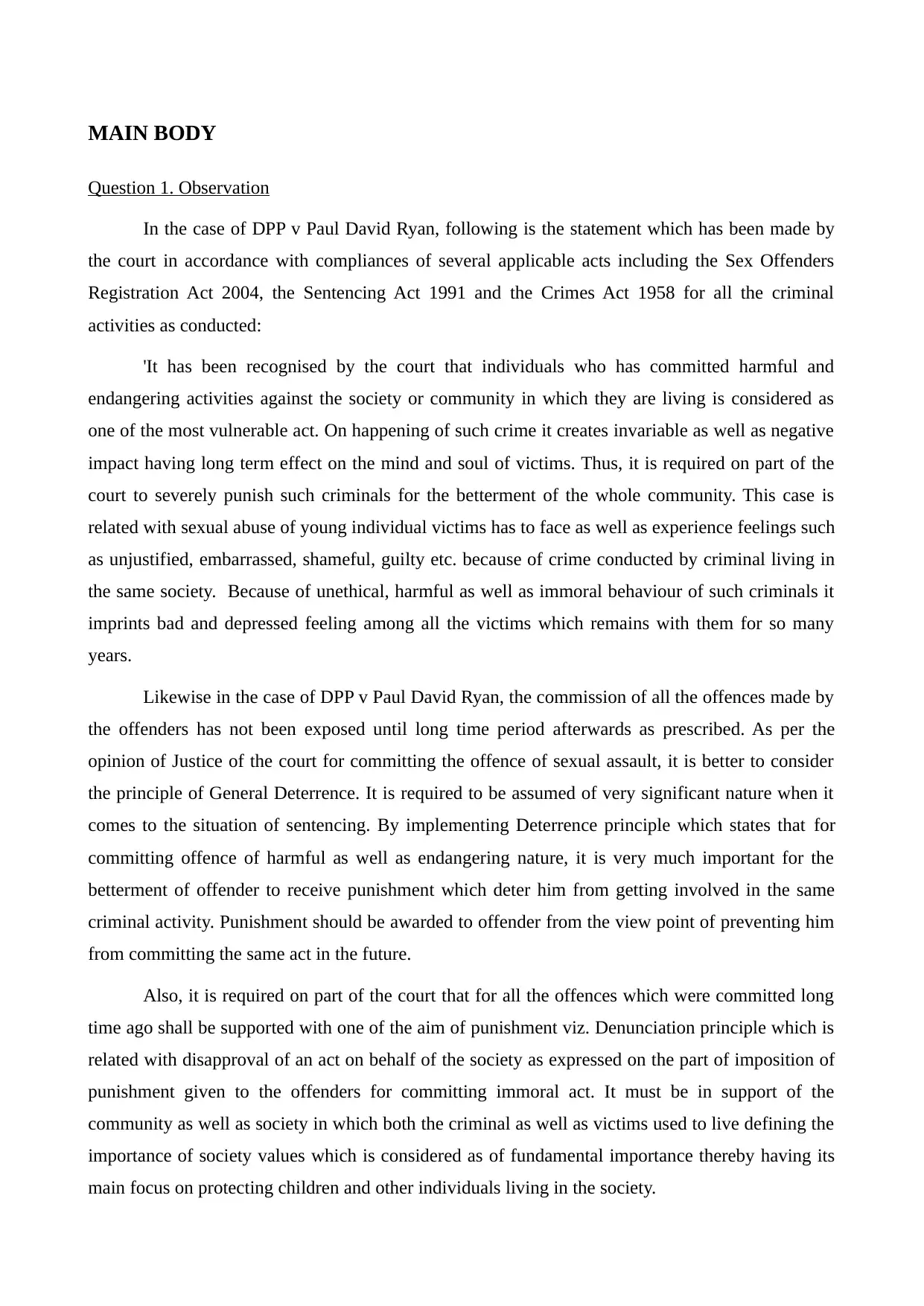
MAIN BODY
Question 1. Observation
In the case of DPP v Paul David Ryan, following is the statement which has been made by
the court in accordance with compliances of several applicable acts including the Sex Offenders
Registration Act 2004, the Sentencing Act 1991 and the Crimes Act 1958 for all the criminal
activities as conducted:
'It has been recognised by the court that individuals who has committed harmful and
endangering activities against the society or community in which they are living is considered as
one of the most vulnerable act. On happening of such crime it creates invariable as well as negative
impact having long term effect on the mind and soul of victims. Thus, it is required on part of the
court to severely punish such criminals for the betterment of the whole community. This case is
related with sexual abuse of young individual victims has to face as well as experience feelings such
as unjustified, embarrassed, shameful, guilty etc. because of crime conducted by criminal living in
the same society. Because of unethical, harmful as well as immoral behaviour of such criminals it
imprints bad and depressed feeling among all the victims which remains with them for so many
years.
Likewise in the case of DPP v Paul David Ryan, the commission of all the offences made by
the offenders has not been exposed until long time period afterwards as prescribed. As per the
opinion of Justice of the court for committing the offence of sexual assault, it is better to consider
the principle of General Deterrence. It is required to be assumed of very significant nature when it
comes to the situation of sentencing. By implementing Deterrence principle which states that for
committing offence of harmful as well as endangering nature, it is very much important for the
betterment of offender to receive punishment which deter him from getting involved in the same
criminal activity. Punishment should be awarded to offender from the view point of preventing him
from committing the same act in the future.
Also, it is required on part of the court that for all the offences which were committed long
time ago shall be supported with one of the aim of punishment viz. Denunciation principle which is
related with disapproval of an act on behalf of the society as expressed on the part of imposition of
punishment given to the offenders for committing immoral act. It must be in support of the
community as well as society in which both the criminal as well as victims used to live defining the
importance of society values which is considered as of fundamental importance thereby having its
main focus on protecting children and other individuals living in the society.
Question 1. Observation
In the case of DPP v Paul David Ryan, following is the statement which has been made by
the court in accordance with compliances of several applicable acts including the Sex Offenders
Registration Act 2004, the Sentencing Act 1991 and the Crimes Act 1958 for all the criminal
activities as conducted:
'It has been recognised by the court that individuals who has committed harmful and
endangering activities against the society or community in which they are living is considered as
one of the most vulnerable act. On happening of such crime it creates invariable as well as negative
impact having long term effect on the mind and soul of victims. Thus, it is required on part of the
court to severely punish such criminals for the betterment of the whole community. This case is
related with sexual abuse of young individual victims has to face as well as experience feelings such
as unjustified, embarrassed, shameful, guilty etc. because of crime conducted by criminal living in
the same society. Because of unethical, harmful as well as immoral behaviour of such criminals it
imprints bad and depressed feeling among all the victims which remains with them for so many
years.
Likewise in the case of DPP v Paul David Ryan, the commission of all the offences made by
the offenders has not been exposed until long time period afterwards as prescribed. As per the
opinion of Justice of the court for committing the offence of sexual assault, it is better to consider
the principle of General Deterrence. It is required to be assumed of very significant nature when it
comes to the situation of sentencing. By implementing Deterrence principle which states that for
committing offence of harmful as well as endangering nature, it is very much important for the
betterment of offender to receive punishment which deter him from getting involved in the same
criminal activity. Punishment should be awarded to offender from the view point of preventing him
from committing the same act in the future.
Also, it is required on part of the court that for all the offences which were committed long
time ago shall be supported with one of the aim of punishment viz. Denunciation principle which is
related with disapproval of an act on behalf of the society as expressed on the part of imposition of
punishment given to the offenders for committing immoral act. It must be in support of the
community as well as society in which both the criminal as well as victims used to live defining the
importance of society values which is considered as of fundamental importance thereby having its
main focus on protecting children and other individuals living in the society.
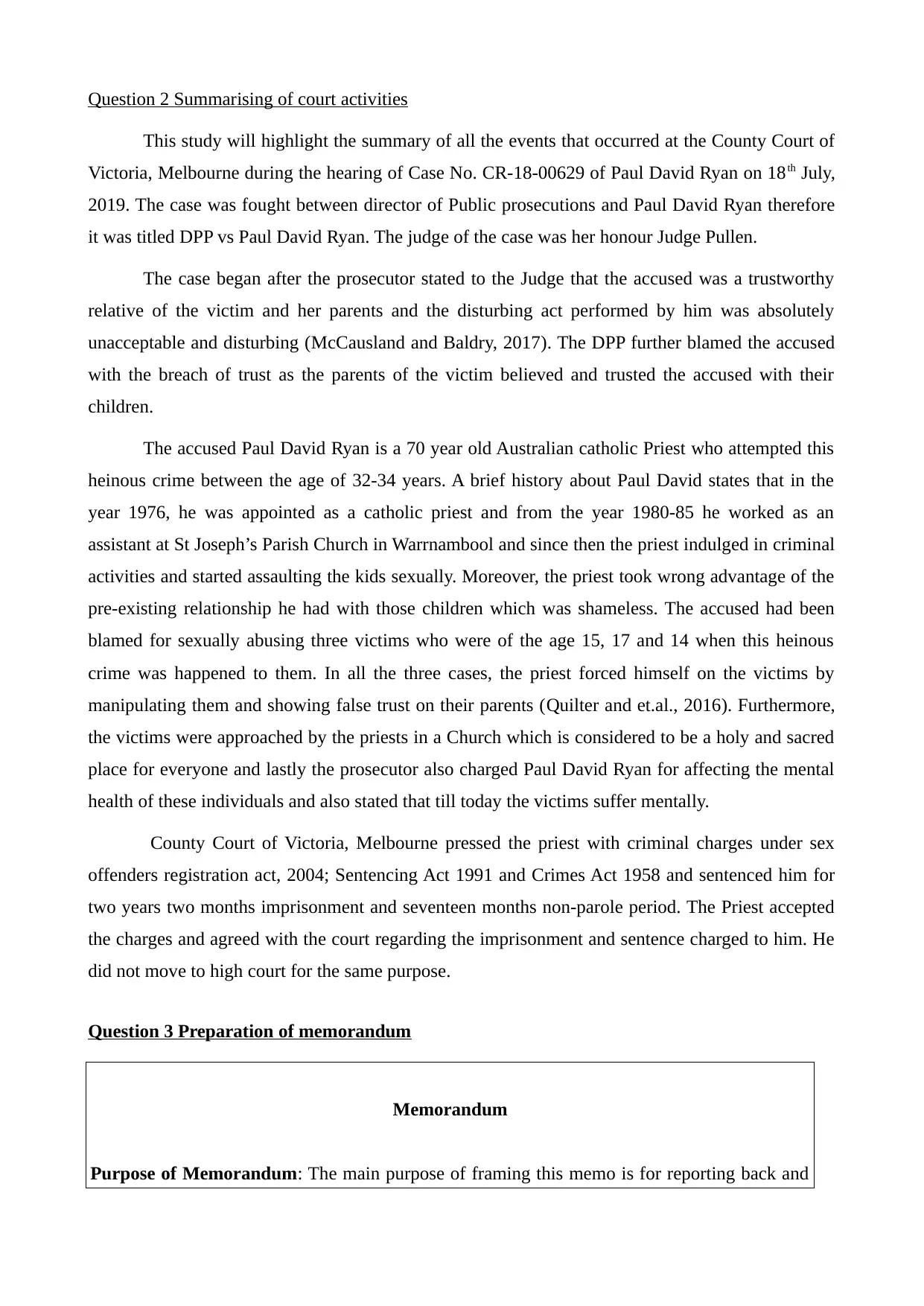
Question 2 Summarising of court activities
This study will highlight the summary of all the events that occurred at the County Court of
Victoria, Melbourne during the hearing of Case No. CR-18-00629 of Paul David Ryan on 18th July,
2019. The case was fought between director of Public prosecutions and Paul David Ryan therefore
it was titled DPP vs Paul David Ryan. The judge of the case was her honour Judge Pullen.
The case began after the prosecutor stated to the Judge that the accused was a trustworthy
relative of the victim and her parents and the disturbing act performed by him was absolutely
unacceptable and disturbing (McCausland and Baldry, 2017). The DPP further blamed the accused
with the breach of trust as the parents of the victim believed and trusted the accused with their
children.
The accused Paul David Ryan is a 70 year old Australian catholic Priest who attempted this
heinous crime between the age of 32-34 years. A brief history about Paul David states that in the
year 1976, he was appointed as a catholic priest and from the year 1980-85 he worked as an
assistant at St Joseph’s Parish Church in Warrnambool and since then the priest indulged in criminal
activities and started assaulting the kids sexually. Moreover, the priest took wrong advantage of the
pre-existing relationship he had with those children which was shameless. The accused had been
blamed for sexually abusing three victims who were of the age 15, 17 and 14 when this heinous
crime was happened to them. In all the three cases, the priest forced himself on the victims by
manipulating them and showing false trust on their parents (Quilter and et.al., 2016). Furthermore,
the victims were approached by the priests in a Church which is considered to be a holy and sacred
place for everyone and lastly the prosecutor also charged Paul David Ryan for affecting the mental
health of these individuals and also stated that till today the victims suffer mentally.
County Court of Victoria, Melbourne pressed the priest with criminal charges under sex
offenders registration act, 2004; Sentencing Act 1991 and Crimes Act 1958 and sentenced him for
two years two months imprisonment and seventeen months non-parole period. The Priest accepted
the charges and agreed with the court regarding the imprisonment and sentence charged to him. He
did not move to high court for the same purpose.
Question 3 Preparation of memorandum
Memorandum
Purpose of Memorandum: The main purpose of framing this memo is for reporting back and
This study will highlight the summary of all the events that occurred at the County Court of
Victoria, Melbourne during the hearing of Case No. CR-18-00629 of Paul David Ryan on 18th July,
2019. The case was fought between director of Public prosecutions and Paul David Ryan therefore
it was titled DPP vs Paul David Ryan. The judge of the case was her honour Judge Pullen.
The case began after the prosecutor stated to the Judge that the accused was a trustworthy
relative of the victim and her parents and the disturbing act performed by him was absolutely
unacceptable and disturbing (McCausland and Baldry, 2017). The DPP further blamed the accused
with the breach of trust as the parents of the victim believed and trusted the accused with their
children.
The accused Paul David Ryan is a 70 year old Australian catholic Priest who attempted this
heinous crime between the age of 32-34 years. A brief history about Paul David states that in the
year 1976, he was appointed as a catholic priest and from the year 1980-85 he worked as an
assistant at St Joseph’s Parish Church in Warrnambool and since then the priest indulged in criminal
activities and started assaulting the kids sexually. Moreover, the priest took wrong advantage of the
pre-existing relationship he had with those children which was shameless. The accused had been
blamed for sexually abusing three victims who were of the age 15, 17 and 14 when this heinous
crime was happened to them. In all the three cases, the priest forced himself on the victims by
manipulating them and showing false trust on their parents (Quilter and et.al., 2016). Furthermore,
the victims were approached by the priests in a Church which is considered to be a holy and sacred
place for everyone and lastly the prosecutor also charged Paul David Ryan for affecting the mental
health of these individuals and also stated that till today the victims suffer mentally.
County Court of Victoria, Melbourne pressed the priest with criminal charges under sex
offenders registration act, 2004; Sentencing Act 1991 and Crimes Act 1958 and sentenced him for
two years two months imprisonment and seventeen months non-parole period. The Priest accepted
the charges and agreed with the court regarding the imprisonment and sentence charged to him. He
did not move to high court for the same purpose.
Question 3 Preparation of memorandum
Memorandum
Purpose of Memorandum: The main purpose of framing this memo is for reporting back and
Secure Best Marks with AI Grader
Need help grading? Try our AI Grader for instant feedback on your assignments.
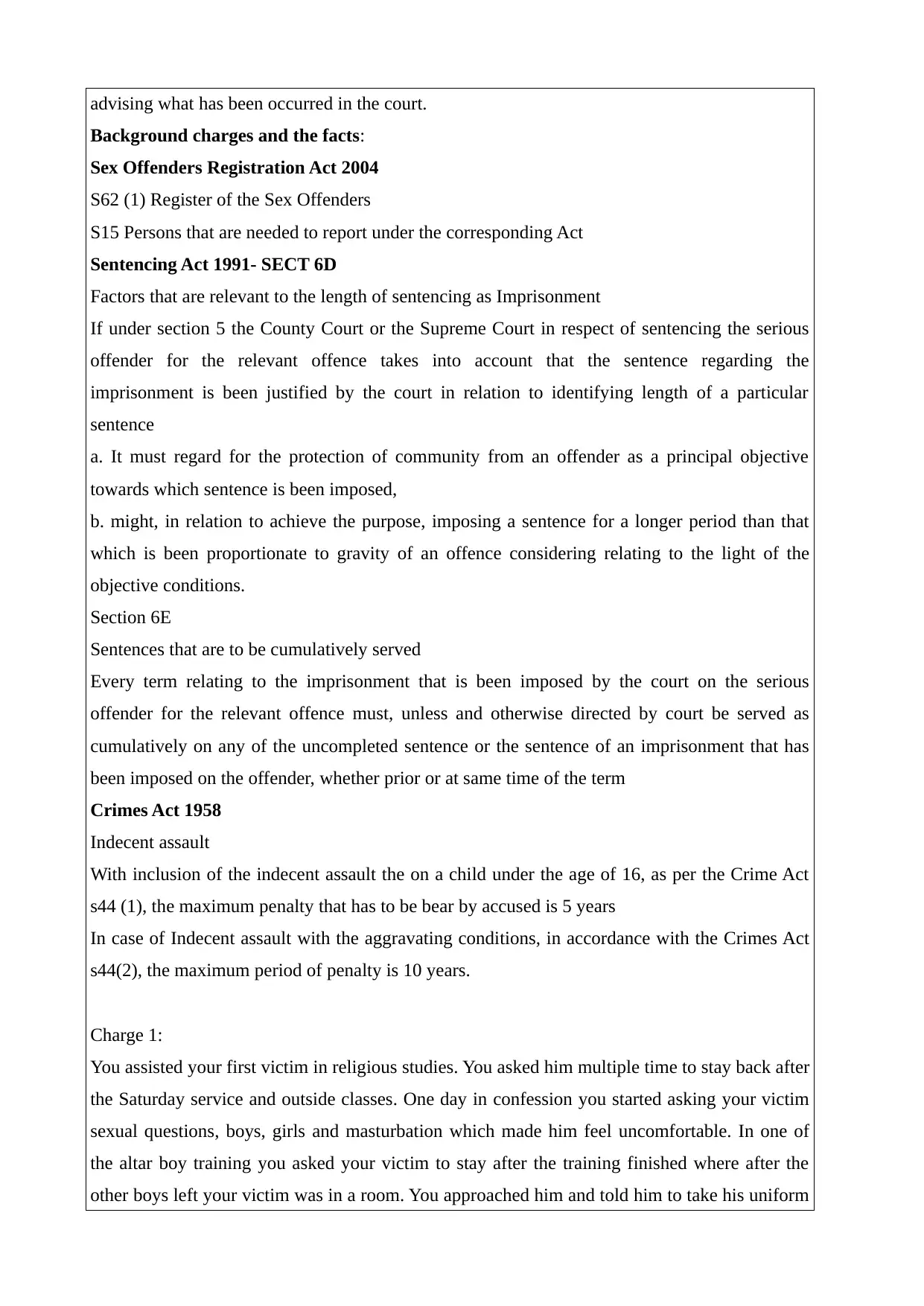
advising what has been occurred in the court.
Background charges and the facts:
Sex Offenders Registration Act 2004
S62 (1) Register of the Sex Offenders
S15 Persons that are needed to report under the corresponding Act
Sentencing Act 1991- SECT 6D
Factors that are relevant to the length of sentencing as Imprisonment
If under section 5 the County Court or the Supreme Court in respect of sentencing the serious
offender for the relevant offence takes into account that the sentence regarding the
imprisonment is been justified by the court in relation to identifying length of a particular
sentence
a. It must regard for the protection of community from an offender as a principal objective
towards which sentence is been imposed,
b. might, in relation to achieve the purpose, imposing a sentence for a longer period than that
which is been proportionate to gravity of an offence considering relating to the light of the
objective conditions.
Section 6E
Sentences that are to be cumulatively served
Every term relating to the imprisonment that is been imposed by the court on the serious
offender for the relevant offence must, unless and otherwise directed by court be served as
cumulatively on any of the uncompleted sentence or the sentence of an imprisonment that has
been imposed on the offender, whether prior or at same time of the term
Crimes Act 1958
Indecent assault
With inclusion of the indecent assault the on a child under the age of 16, as per the Crime Act
s44 (1), the maximum penalty that has to be bear by accused is 5 years
In case of Indecent assault with the aggravating conditions, in accordance with the Crimes Act
s44(2), the maximum period of penalty is 10 years.
Charge 1:
You assisted your first victim in religious studies. You asked him multiple time to stay back after
the Saturday service and outside classes. One day in confession you started asking your victim
sexual questions, boys, girls and masturbation which made him feel uncomfortable. In one of
the altar boy training you asked your victim to stay after the training finished where after the
other boys left your victim was in a room. You approached him and told him to take his uniform
Background charges and the facts:
Sex Offenders Registration Act 2004
S62 (1) Register of the Sex Offenders
S15 Persons that are needed to report under the corresponding Act
Sentencing Act 1991- SECT 6D
Factors that are relevant to the length of sentencing as Imprisonment
If under section 5 the County Court or the Supreme Court in respect of sentencing the serious
offender for the relevant offence takes into account that the sentence regarding the
imprisonment is been justified by the court in relation to identifying length of a particular
sentence
a. It must regard for the protection of community from an offender as a principal objective
towards which sentence is been imposed,
b. might, in relation to achieve the purpose, imposing a sentence for a longer period than that
which is been proportionate to gravity of an offence considering relating to the light of the
objective conditions.
Section 6E
Sentences that are to be cumulatively served
Every term relating to the imprisonment that is been imposed by the court on the serious
offender for the relevant offence must, unless and otherwise directed by court be served as
cumulatively on any of the uncompleted sentence or the sentence of an imprisonment that has
been imposed on the offender, whether prior or at same time of the term
Crimes Act 1958
Indecent assault
With inclusion of the indecent assault the on a child under the age of 16, as per the Crime Act
s44 (1), the maximum penalty that has to be bear by accused is 5 years
In case of Indecent assault with the aggravating conditions, in accordance with the Crimes Act
s44(2), the maximum period of penalty is 10 years.
Charge 1:
You assisted your first victim in religious studies. You asked him multiple time to stay back after
the Saturday service and outside classes. One day in confession you started asking your victim
sexual questions, boys, girls and masturbation which made him feel uncomfortable. In one of
the altar boy training you asked your victim to stay after the training finished where after the
other boys left your victim was in a room. You approached him and told him to take his uniform
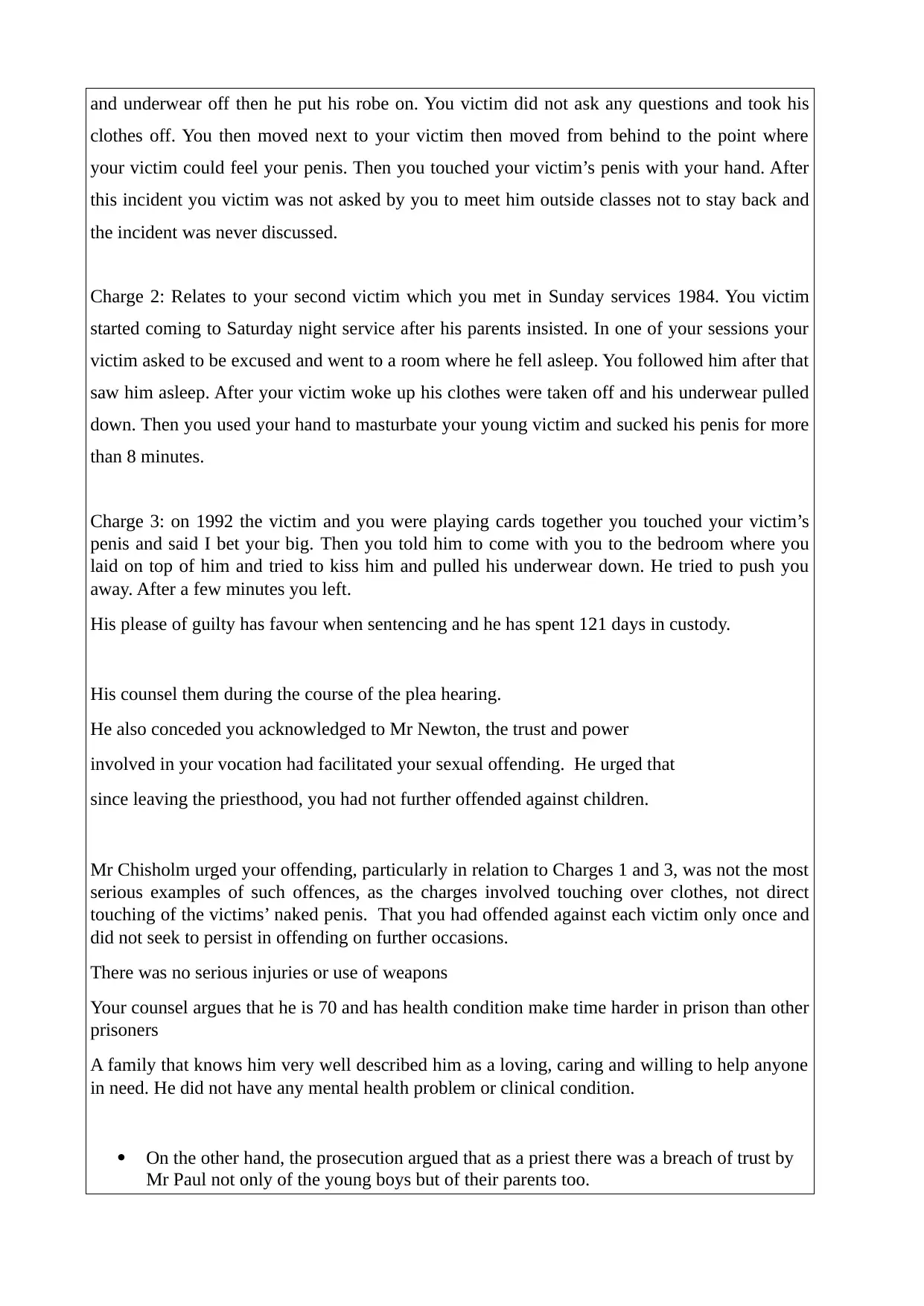
and underwear off then he put his robe on. You victim did not ask any questions and took his
clothes off. You then moved next to your victim then moved from behind to the point where
your victim could feel your penis. Then you touched your victim’s penis with your hand. After
this incident you victim was not asked by you to meet him outside classes not to stay back and
the incident was never discussed.
Charge 2: Relates to your second victim which you met in Sunday services 1984. You victim
started coming to Saturday night service after his parents insisted. In one of your sessions your
victim asked to be excused and went to a room where he fell asleep. You followed him after that
saw him asleep. After your victim woke up his clothes were taken off and his underwear pulled
down. Then you used your hand to masturbate your young victim and sucked his penis for more
than 8 minutes.
Charge 3: on 1992 the victim and you were playing cards together you touched your victim’s
penis and said I bet your big. Then you told him to come with you to the bedroom where you
laid on top of him and tried to kiss him and pulled his underwear down. He tried to push you
away. After a few minutes you left.
His please of guilty has favour when sentencing and he has spent 121 days in custody.
His counsel them during the course of the plea hearing.
He also conceded you acknowledged to Mr Newton, the trust and power
involved in your vocation had facilitated your sexual offending. He urged that
since leaving the priesthood, you had not further offended against children.
Mr Chisholm urged your offending, particularly in relation to Charges 1 and 3, was not the most
serious examples of such offences, as the charges involved touching over clothes, not direct
touching of the victims’ naked penis. That you had offended against each victim only once and
did not seek to persist in offending on further occasions.
There was no serious injuries or use of weapons
Your counsel argues that he is 70 and has health condition make time harder in prison than other
prisoners
A family that knows him very well described him as a loving, caring and willing to help anyone
in need. He did not have any mental health problem or clinical condition.
On the other hand, the prosecution argued that as a priest there was a breach of trust by
Mr Paul not only of the young boys but of their parents too.
clothes off. You then moved next to your victim then moved from behind to the point where
your victim could feel your penis. Then you touched your victim’s penis with your hand. After
this incident you victim was not asked by you to meet him outside classes not to stay back and
the incident was never discussed.
Charge 2: Relates to your second victim which you met in Sunday services 1984. You victim
started coming to Saturday night service after his parents insisted. In one of your sessions your
victim asked to be excused and went to a room where he fell asleep. You followed him after that
saw him asleep. After your victim woke up his clothes were taken off and his underwear pulled
down. Then you used your hand to masturbate your young victim and sucked his penis for more
than 8 minutes.
Charge 3: on 1992 the victim and you were playing cards together you touched your victim’s
penis and said I bet your big. Then you told him to come with you to the bedroom where you
laid on top of him and tried to kiss him and pulled his underwear down. He tried to push you
away. After a few minutes you left.
His please of guilty has favour when sentencing and he has spent 121 days in custody.
His counsel them during the course of the plea hearing.
He also conceded you acknowledged to Mr Newton, the trust and power
involved in your vocation had facilitated your sexual offending. He urged that
since leaving the priesthood, you had not further offended against children.
Mr Chisholm urged your offending, particularly in relation to Charges 1 and 3, was not the most
serious examples of such offences, as the charges involved touching over clothes, not direct
touching of the victims’ naked penis. That you had offended against each victim only once and
did not seek to persist in offending on further occasions.
There was no serious injuries or use of weapons
Your counsel argues that he is 70 and has health condition make time harder in prison than other
prisoners
A family that knows him very well described him as a loving, caring and willing to help anyone
in need. He did not have any mental health problem or clinical condition.
On the other hand, the prosecution argued that as a priest there was a breach of trust by
Mr Paul not only of the young boys but of their parents too.
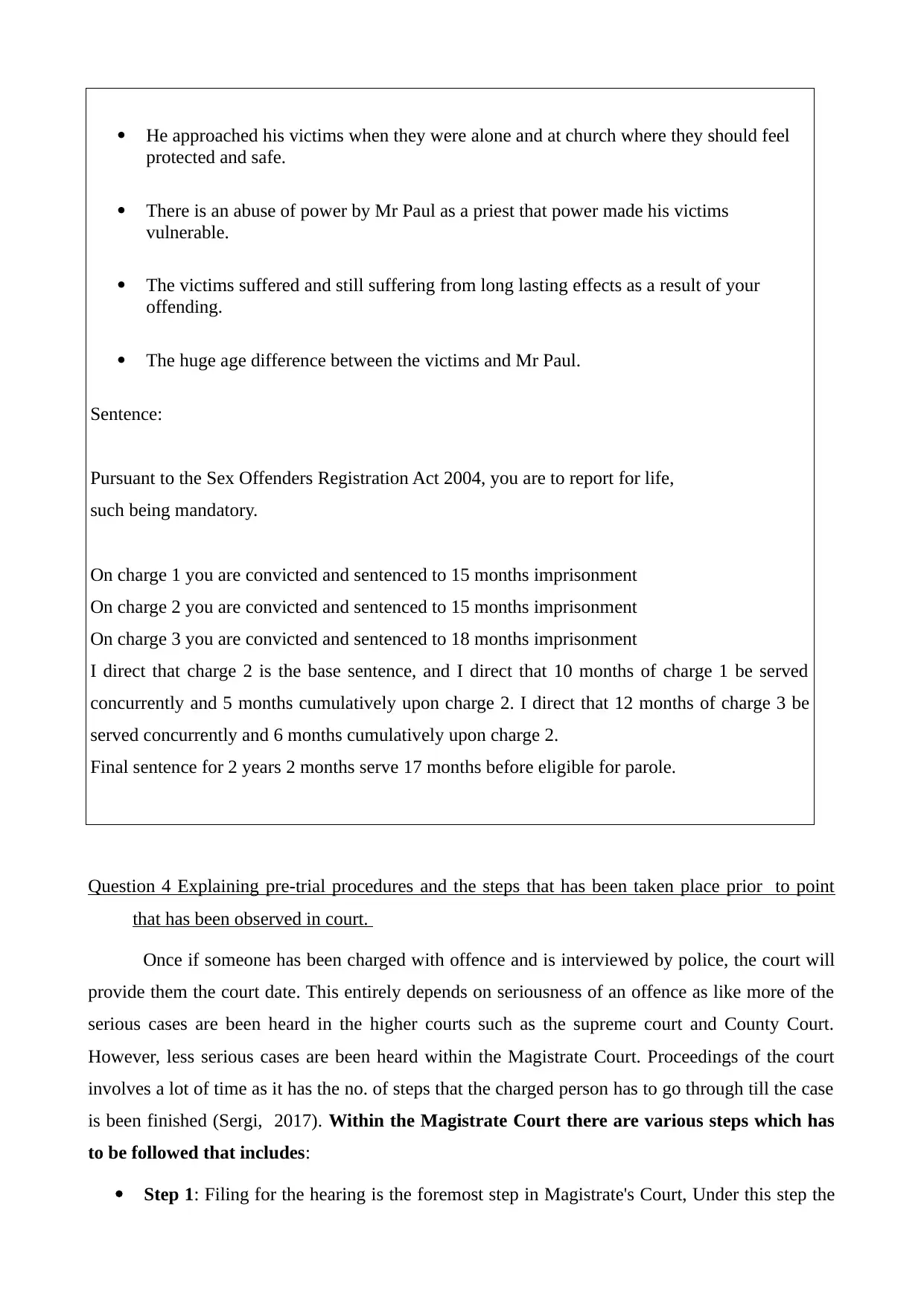
He approached his victims when they were alone and at church where they should feel
protected and safe.
There is an abuse of power by Mr Paul as a priest that power made his victims
vulnerable.
The victims suffered and still suffering from long lasting effects as a result of your
offending.
The huge age difference between the victims and Mr Paul.
Sentence:
Pursuant to the Sex Offenders Registration Act 2004, you are to report for life,
such being mandatory.
On charge 1 you are convicted and sentenced to 15 months imprisonment
On charge 2 you are convicted and sentenced to 15 months imprisonment
On charge 3 you are convicted and sentenced to 18 months imprisonment
I direct that charge 2 is the base sentence, and I direct that 10 months of charge 1 be served
concurrently and 5 months cumulatively upon charge 2. I direct that 12 months of charge 3 be
served concurrently and 6 months cumulatively upon charge 2.
Final sentence for 2 years 2 months serve 17 months before eligible for parole.
Question 4 Explaining pre-trial procedures and the steps that has been taken place prior to point
that has been observed in court.
Once if someone has been charged with offence and is interviewed by police, the court will
provide them the court date. This entirely depends on seriousness of an offence as like more of the
serious cases are been heard in the higher courts such as the supreme court and County Court.
However, less serious cases are been heard within the Magistrate Court. Proceedings of the court
involves a lot of time as it has the no. of steps that the charged person has to go through till the case
is been finished (Sergi, 2017). Within the Magistrate Court there are various steps which has
to be followed that includes:
Step 1: Filing for the hearing is the foremost step in Magistrate's Court, Under this step the
protected and safe.
There is an abuse of power by Mr Paul as a priest that power made his victims
vulnerable.
The victims suffered and still suffering from long lasting effects as a result of your
offending.
The huge age difference between the victims and Mr Paul.
Sentence:
Pursuant to the Sex Offenders Registration Act 2004, you are to report for life,
such being mandatory.
On charge 1 you are convicted and sentenced to 15 months imprisonment
On charge 2 you are convicted and sentenced to 15 months imprisonment
On charge 3 you are convicted and sentenced to 18 months imprisonment
I direct that charge 2 is the base sentence, and I direct that 10 months of charge 1 be served
concurrently and 5 months cumulatively upon charge 2. I direct that 12 months of charge 3 be
served concurrently and 6 months cumulatively upon charge 2.
Final sentence for 2 years 2 months serve 17 months before eligible for parole.
Question 4 Explaining pre-trial procedures and the steps that has been taken place prior to point
that has been observed in court.
Once if someone has been charged with offence and is interviewed by police, the court will
provide them the court date. This entirely depends on seriousness of an offence as like more of the
serious cases are been heard in the higher courts such as the supreme court and County Court.
However, less serious cases are been heard within the Magistrate Court. Proceedings of the court
involves a lot of time as it has the no. of steps that the charged person has to go through till the case
is been finished (Sergi, 2017). Within the Magistrate Court there are various steps which has
to be followed that includes:
Step 1: Filing for the hearing is the foremost step in Magistrate's Court, Under this step the
Paraphrase This Document
Need a fresh take? Get an instant paraphrase of this document with our AI Paraphraser
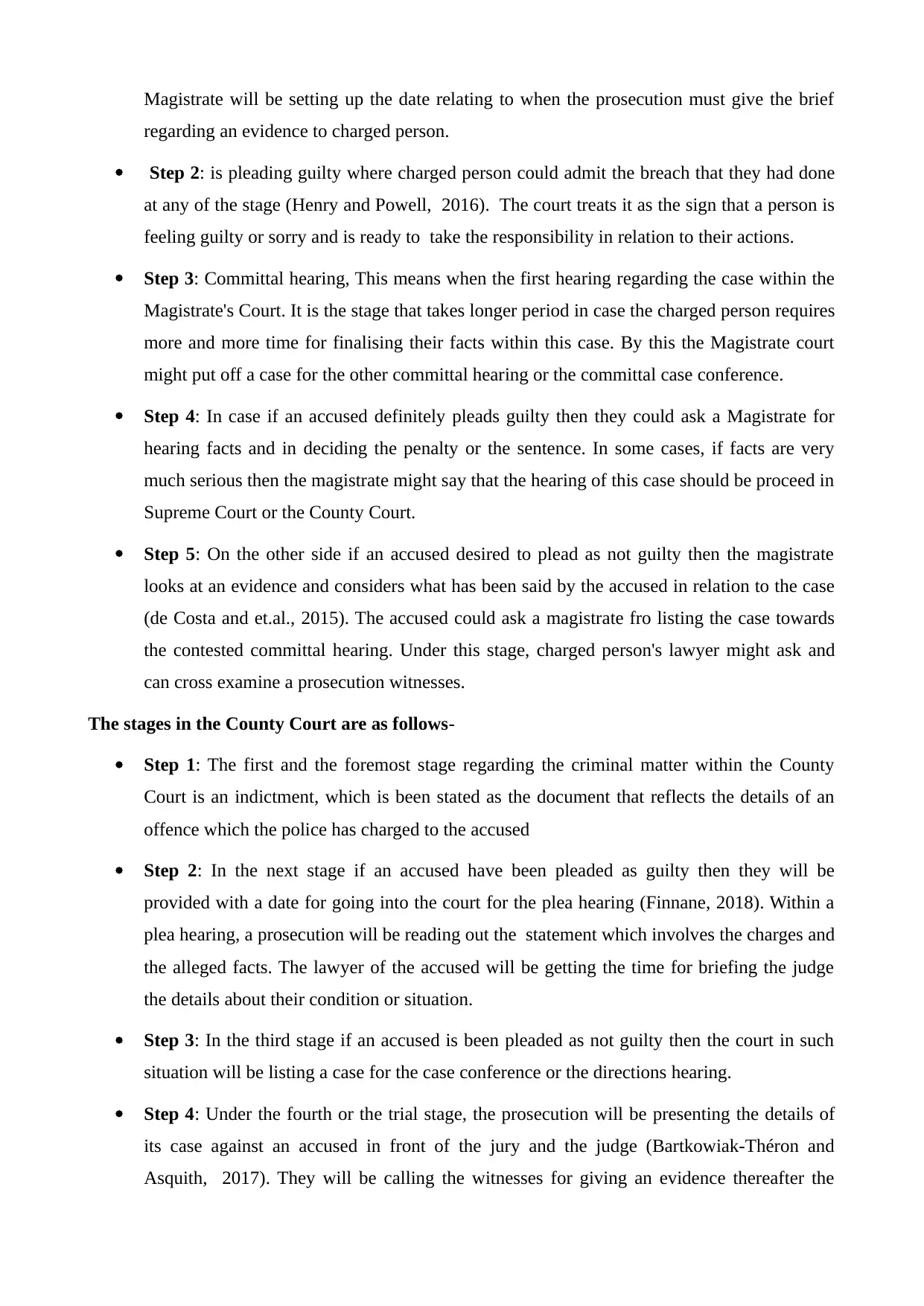
Magistrate will be setting up the date relating to when the prosecution must give the brief
regarding an evidence to charged person.
Step 2: is pleading guilty where charged person could admit the breach that they had done
at any of the stage (Henry and Powell, 2016). The court treats it as the sign that a person is
feeling guilty or sorry and is ready to take the responsibility in relation to their actions.
Step 3: Committal hearing, This means when the first hearing regarding the case within the
Magistrate's Court. It is the stage that takes longer period in case the charged person requires
more and more time for finalising their facts within this case. By this the Magistrate court
might put off a case for the other committal hearing or the committal case conference.
Step 4: In case if an accused definitely pleads guilty then they could ask a Magistrate for
hearing facts and in deciding the penalty or the sentence. In some cases, if facts are very
much serious then the magistrate might say that the hearing of this case should be proceed in
Supreme Court or the County Court.
Step 5: On the other side if an accused desired to plead as not guilty then the magistrate
looks at an evidence and considers what has been said by the accused in relation to the case
(de Costa and et.al., 2015). The accused could ask a magistrate fro listing the case towards
the contested committal hearing. Under this stage, charged person's lawyer might ask and
can cross examine a prosecution witnesses.
The stages in the County Court are as follows-
Step 1: The first and the foremost stage regarding the criminal matter within the County
Court is an indictment, which is been stated as the document that reflects the details of an
offence which the police has charged to the accused
Step 2: In the next stage if an accused have been pleaded as guilty then they will be
provided with a date for going into the court for the plea hearing (Finnane, 2018). Within a
plea hearing, a prosecution will be reading out the statement which involves the charges and
the alleged facts. The lawyer of the accused will be getting the time for briefing the judge
the details about their condition or situation.
Step 3: In the third stage if an accused is been pleaded as not guilty then the court in such
situation will be listing a case for the case conference or the directions hearing.
Step 4: Under the fourth or the trial stage, the prosecution will be presenting the details of
its case against an accused in front of the jury and the judge (Bartkowiak-Théron and
Asquith, 2017). They will be calling the witnesses for giving an evidence thereafter the
regarding an evidence to charged person.
Step 2: is pleading guilty where charged person could admit the breach that they had done
at any of the stage (Henry and Powell, 2016). The court treats it as the sign that a person is
feeling guilty or sorry and is ready to take the responsibility in relation to their actions.
Step 3: Committal hearing, This means when the first hearing regarding the case within the
Magistrate's Court. It is the stage that takes longer period in case the charged person requires
more and more time for finalising their facts within this case. By this the Magistrate court
might put off a case for the other committal hearing or the committal case conference.
Step 4: In case if an accused definitely pleads guilty then they could ask a Magistrate for
hearing facts and in deciding the penalty or the sentence. In some cases, if facts are very
much serious then the magistrate might say that the hearing of this case should be proceed in
Supreme Court or the County Court.
Step 5: On the other side if an accused desired to plead as not guilty then the magistrate
looks at an evidence and considers what has been said by the accused in relation to the case
(de Costa and et.al., 2015). The accused could ask a magistrate fro listing the case towards
the contested committal hearing. Under this stage, charged person's lawyer might ask and
can cross examine a prosecution witnesses.
The stages in the County Court are as follows-
Step 1: The first and the foremost stage regarding the criminal matter within the County
Court is an indictment, which is been stated as the document that reflects the details of an
offence which the police has charged to the accused
Step 2: In the next stage if an accused have been pleaded as guilty then they will be
provided with a date for going into the court for the plea hearing (Finnane, 2018). Within a
plea hearing, a prosecution will be reading out the statement which involves the charges and
the alleged facts. The lawyer of the accused will be getting the time for briefing the judge
the details about their condition or situation.
Step 3: In the third stage if an accused is been pleaded as not guilty then the court in such
situation will be listing a case for the case conference or the directions hearing.
Step 4: Under the fourth or the trial stage, the prosecution will be presenting the details of
its case against an accused in front of the jury and the judge (Bartkowiak-Théron and
Asquith, 2017). They will be calling the witnesses for giving an evidence thereafter the
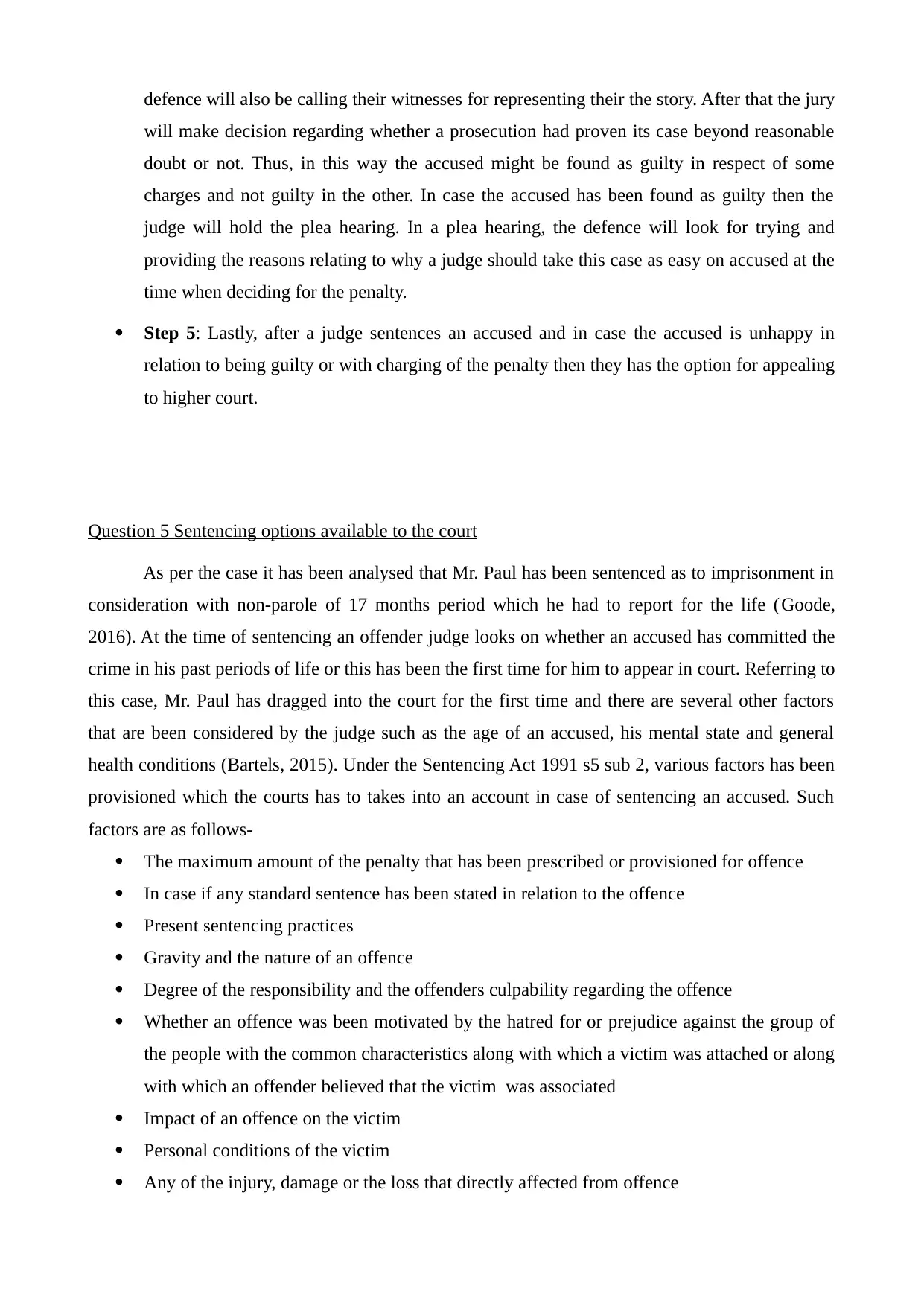
defence will also be calling their witnesses for representing their the story. After that the jury
will make decision regarding whether a prosecution had proven its case beyond reasonable
doubt or not. Thus, in this way the accused might be found as guilty in respect of some
charges and not guilty in the other. In case the accused has been found as guilty then the
judge will hold the plea hearing. In a plea hearing, the defence will look for trying and
providing the reasons relating to why a judge should take this case as easy on accused at the
time when deciding for the penalty.
Step 5: Lastly, after a judge sentences an accused and in case the accused is unhappy in
relation to being guilty or with charging of the penalty then they has the option for appealing
to higher court.
Question 5 Sentencing options available to the court
As per the case it has been analysed that Mr. Paul has been sentenced as to imprisonment in
consideration with non-parole of 17 months period which he had to report for the life (Goode,
2016). At the time of sentencing an offender judge looks on whether an accused has committed the
crime in his past periods of life or this has been the first time for him to appear in court. Referring to
this case, Mr. Paul has dragged into the court for the first time and there are several other factors
that are been considered by the judge such as the age of an accused, his mental state and general
health conditions (Bartels, 2015). Under the Sentencing Act 1991 s5 sub 2, various factors has been
provisioned which the courts has to takes into an account in case of sentencing an accused. Such
factors are as follows-
The maximum amount of the penalty that has been prescribed or provisioned for offence
In case if any standard sentence has been stated in relation to the offence
Present sentencing practices
Gravity and the nature of an offence
Degree of the responsibility and the offenders culpability regarding the offence
Whether an offence was been motivated by the hatred for or prejudice against the group of
the people with the common characteristics along with which a victim was attached or along
with which an offender believed that the victim was associated
Impact of an offence on the victim
Personal conditions of the victim
Any of the injury, damage or the loss that directly affected from offence
will make decision regarding whether a prosecution had proven its case beyond reasonable
doubt or not. Thus, in this way the accused might be found as guilty in respect of some
charges and not guilty in the other. In case the accused has been found as guilty then the
judge will hold the plea hearing. In a plea hearing, the defence will look for trying and
providing the reasons relating to why a judge should take this case as easy on accused at the
time when deciding for the penalty.
Step 5: Lastly, after a judge sentences an accused and in case the accused is unhappy in
relation to being guilty or with charging of the penalty then they has the option for appealing
to higher court.
Question 5 Sentencing options available to the court
As per the case it has been analysed that Mr. Paul has been sentenced as to imprisonment in
consideration with non-parole of 17 months period which he had to report for the life (Goode,
2016). At the time of sentencing an offender judge looks on whether an accused has committed the
crime in his past periods of life or this has been the first time for him to appear in court. Referring to
this case, Mr. Paul has dragged into the court for the first time and there are several other factors
that are been considered by the judge such as the age of an accused, his mental state and general
health conditions (Bartels, 2015). Under the Sentencing Act 1991 s5 sub 2, various factors has been
provisioned which the courts has to takes into an account in case of sentencing an accused. Such
factors are as follows-
The maximum amount of the penalty that has been prescribed or provisioned for offence
In case if any standard sentence has been stated in relation to the offence
Present sentencing practices
Gravity and the nature of an offence
Degree of the responsibility and the offenders culpability regarding the offence
Whether an offence was been motivated by the hatred for or prejudice against the group of
the people with the common characteristics along with which a victim was attached or along
with which an offender believed that the victim was associated
Impact of an offence on the victim
Personal conditions of the victim
Any of the injury, damage or the loss that directly affected from offence
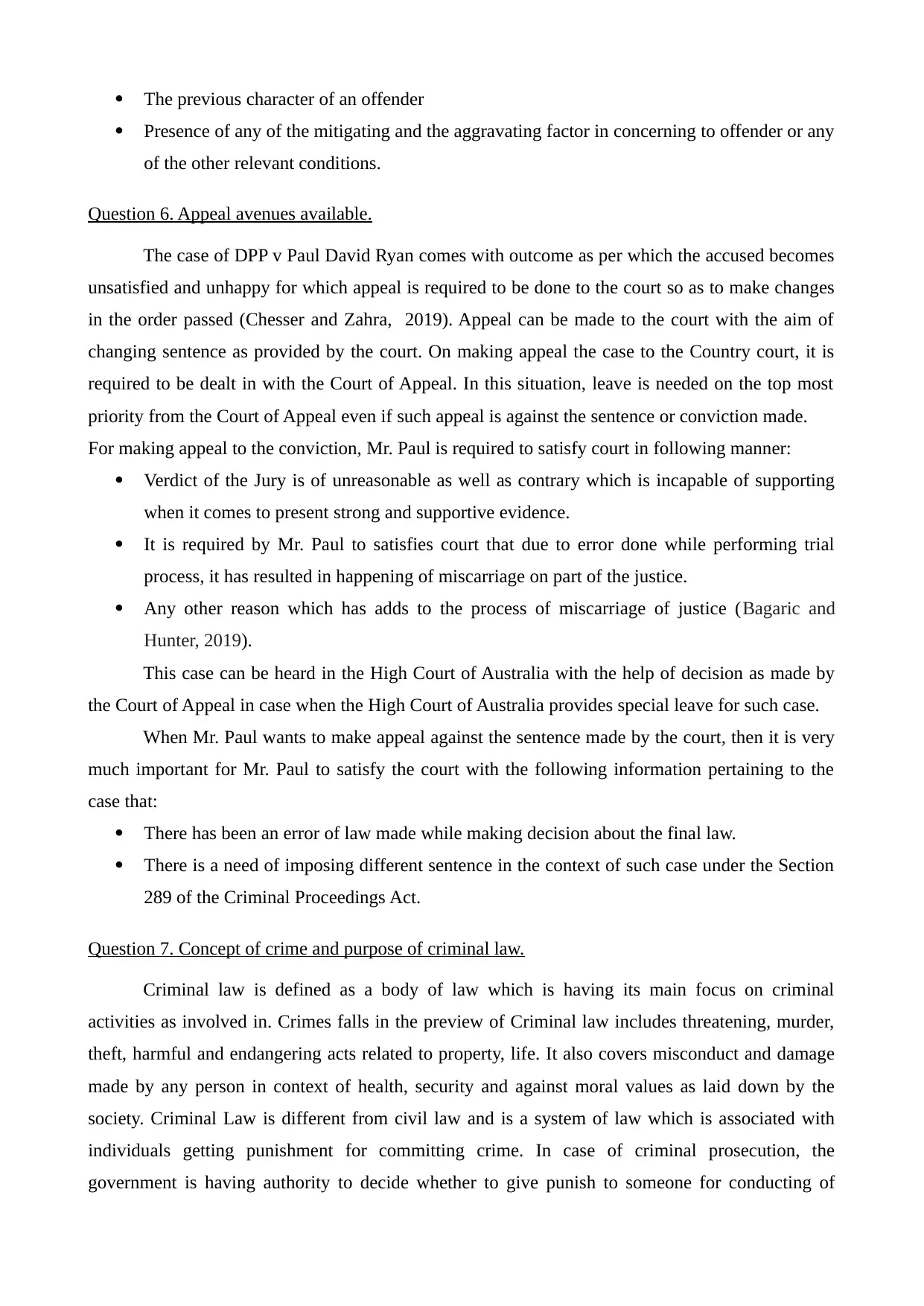
The previous character of an offender
Presence of any of the mitigating and the aggravating factor in concerning to offender or any
of the other relevant conditions.
Question 6. Appeal avenues available.
The case of DPP v Paul David Ryan comes with outcome as per which the accused becomes
unsatisfied and unhappy for which appeal is required to be done to the court so as to make changes
in the order passed (Chesser and Zahra, 2019). Appeal can be made to the court with the aim of
changing sentence as provided by the court. On making appeal the case to the Country court, it is
required to be dealt in with the Court of Appeal. In this situation, leave is needed on the top most
priority from the Court of Appeal even if such appeal is against the sentence or conviction made.
For making appeal to the conviction, Mr. Paul is required to satisfy court in following manner:
Verdict of the Jury is of unreasonable as well as contrary which is incapable of supporting
when it comes to present strong and supportive evidence.
It is required by Mr. Paul to satisfies court that due to error done while performing trial
process, it has resulted in happening of miscarriage on part of the justice.
Any other reason which has adds to the process of miscarriage of justice (Bagaric and
Hunter, 2019).
This case can be heard in the High Court of Australia with the help of decision as made by
the Court of Appeal in case when the High Court of Australia provides special leave for such case.
When Mr. Paul wants to make appeal against the sentence made by the court, then it is very
much important for Mr. Paul to satisfy the court with the following information pertaining to the
case that:
There has been an error of law made while making decision about the final law.
There is a need of imposing different sentence in the context of such case under the Section
289 of the Criminal Proceedings Act.
Question 7. Concept of crime and purpose of criminal law.
Criminal law is defined as a body of law which is having its main focus on criminal
activities as involved in. Crimes falls in the preview of Criminal law includes threatening, murder,
theft, harmful and endangering acts related to property, life. It also covers misconduct and damage
made by any person in context of health, security and against moral values as laid down by the
society. Criminal Law is different from civil law and is a system of law which is associated with
individuals getting punishment for committing crime. In case of criminal prosecution, the
government is having authority to decide whether to give punish to someone for conducting of
Presence of any of the mitigating and the aggravating factor in concerning to offender or any
of the other relevant conditions.
Question 6. Appeal avenues available.
The case of DPP v Paul David Ryan comes with outcome as per which the accused becomes
unsatisfied and unhappy for which appeal is required to be done to the court so as to make changes
in the order passed (Chesser and Zahra, 2019). Appeal can be made to the court with the aim of
changing sentence as provided by the court. On making appeal the case to the Country court, it is
required to be dealt in with the Court of Appeal. In this situation, leave is needed on the top most
priority from the Court of Appeal even if such appeal is against the sentence or conviction made.
For making appeal to the conviction, Mr. Paul is required to satisfy court in following manner:
Verdict of the Jury is of unreasonable as well as contrary which is incapable of supporting
when it comes to present strong and supportive evidence.
It is required by Mr. Paul to satisfies court that due to error done while performing trial
process, it has resulted in happening of miscarriage on part of the justice.
Any other reason which has adds to the process of miscarriage of justice (Bagaric and
Hunter, 2019).
This case can be heard in the High Court of Australia with the help of decision as made by
the Court of Appeal in case when the High Court of Australia provides special leave for such case.
When Mr. Paul wants to make appeal against the sentence made by the court, then it is very
much important for Mr. Paul to satisfy the court with the following information pertaining to the
case that:
There has been an error of law made while making decision about the final law.
There is a need of imposing different sentence in the context of such case under the Section
289 of the Criminal Proceedings Act.
Question 7. Concept of crime and purpose of criminal law.
Criminal law is defined as a body of law which is having its main focus on criminal
activities as involved in. Crimes falls in the preview of Criminal law includes threatening, murder,
theft, harmful and endangering acts related to property, life. It also covers misconduct and damage
made by any person in context of health, security and against moral values as laid down by the
society. Criminal Law is different from civil law and is a system of law which is associated with
individuals getting punishment for committing crime. In case of criminal prosecution, the
government is having authority to decide whether to give punish to someone for conducting of
Secure Best Marks with AI Grader
Need help grading? Try our AI Grader for instant feedback on your assignments.
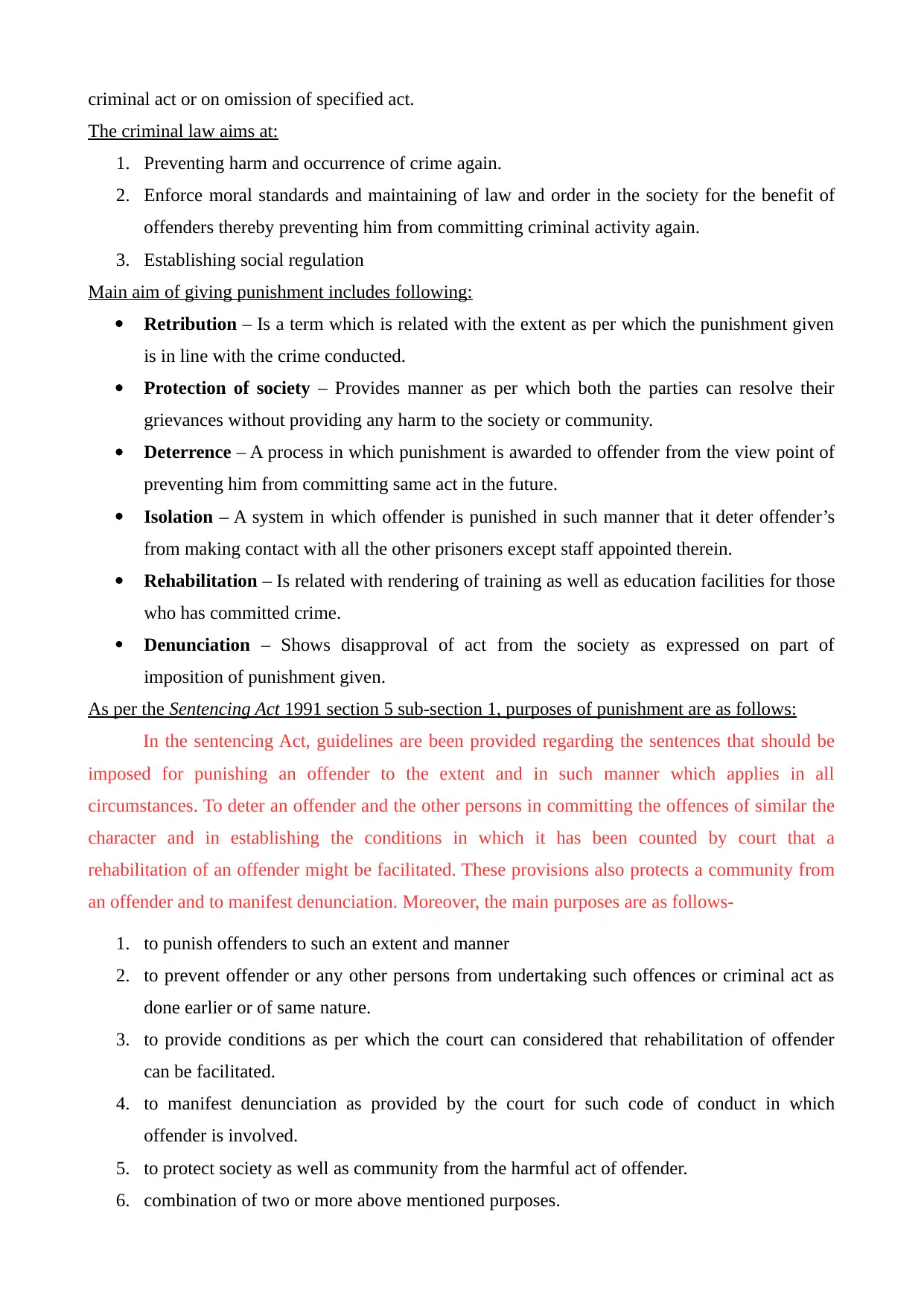
criminal act or on omission of specified act.
The criminal law aims at:
1. Preventing harm and occurrence of crime again.
2. Enforce moral standards and maintaining of law and order in the society for the benefit of
offenders thereby preventing him from committing criminal activity again.
3. Establishing social regulation
Main aim of giving punishment includes following:
Retribution – Is a term which is related with the extent as per which the punishment given
is in line with the crime conducted.
Protection of society – Provides manner as per which both the parties can resolve their
grievances without providing any harm to the society or community.
Deterrence – A process in which punishment is awarded to offender from the view point of
preventing him from committing same act in the future.
Isolation – A system in which offender is punished in such manner that it deter offender’s
from making contact with all the other prisoners except staff appointed therein.
Rehabilitation – Is related with rendering of training as well as education facilities for those
who has committed crime.
Denunciation – Shows disapproval of act from the society as expressed on part of
imposition of punishment given.
As per the Sentencing Act 1991 section 5 sub-section 1, purposes of punishment are as follows:
In the sentencing Act, guidelines are been provided regarding the sentences that should be
imposed for punishing an offender to the extent and in such manner which applies in all
circumstances. To deter an offender and the other persons in committing the offences of similar the
character and in establishing the conditions in which it has been counted by court that a
rehabilitation of an offender might be facilitated. These provisions also protects a community from
an offender and to manifest denunciation. Moreover, the main purposes are as follows-
1. to punish offenders to such an extent and manner
2. to prevent offender or any other persons from undertaking such offences or criminal act as
done earlier or of same nature.
3. to provide conditions as per which the court can considered that rehabilitation of offender
can be facilitated.
4. to manifest denunciation as provided by the court for such code of conduct in which
offender is involved.
5. to protect society as well as community from the harmful act of offender.
6. combination of two or more above mentioned purposes.
The criminal law aims at:
1. Preventing harm and occurrence of crime again.
2. Enforce moral standards and maintaining of law and order in the society for the benefit of
offenders thereby preventing him from committing criminal activity again.
3. Establishing social regulation
Main aim of giving punishment includes following:
Retribution – Is a term which is related with the extent as per which the punishment given
is in line with the crime conducted.
Protection of society – Provides manner as per which both the parties can resolve their
grievances without providing any harm to the society or community.
Deterrence – A process in which punishment is awarded to offender from the view point of
preventing him from committing same act in the future.
Isolation – A system in which offender is punished in such manner that it deter offender’s
from making contact with all the other prisoners except staff appointed therein.
Rehabilitation – Is related with rendering of training as well as education facilities for those
who has committed crime.
Denunciation – Shows disapproval of act from the society as expressed on part of
imposition of punishment given.
As per the Sentencing Act 1991 section 5 sub-section 1, purposes of punishment are as follows:
In the sentencing Act, guidelines are been provided regarding the sentences that should be
imposed for punishing an offender to the extent and in such manner which applies in all
circumstances. To deter an offender and the other persons in committing the offences of similar the
character and in establishing the conditions in which it has been counted by court that a
rehabilitation of an offender might be facilitated. These provisions also protects a community from
an offender and to manifest denunciation. Moreover, the main purposes are as follows-
1. to punish offenders to such an extent and manner
2. to prevent offender or any other persons from undertaking such offences or criminal act as
done earlier or of same nature.
3. to provide conditions as per which the court can considered that rehabilitation of offender
can be facilitated.
4. to manifest denunciation as provided by the court for such code of conduct in which
offender is involved.
5. to protect society as well as community from the harmful act of offender.
6. combination of two or more above mentioned purposes.

The aim of providing punishment to offender is to make realise about crime as conducted on
part of him which is against the morale and safety of the community. By defining social regulations,
standards and norms related to criminal law, it can help individual in understanding meaning of
wrongful acts and prevent from occurrence of such acts in the future.
part of him which is against the morale and safety of the community. By defining social regulations,
standards and norms related to criminal law, it can help individual in understanding meaning of
wrongful acts and prevent from occurrence of such acts in the future.
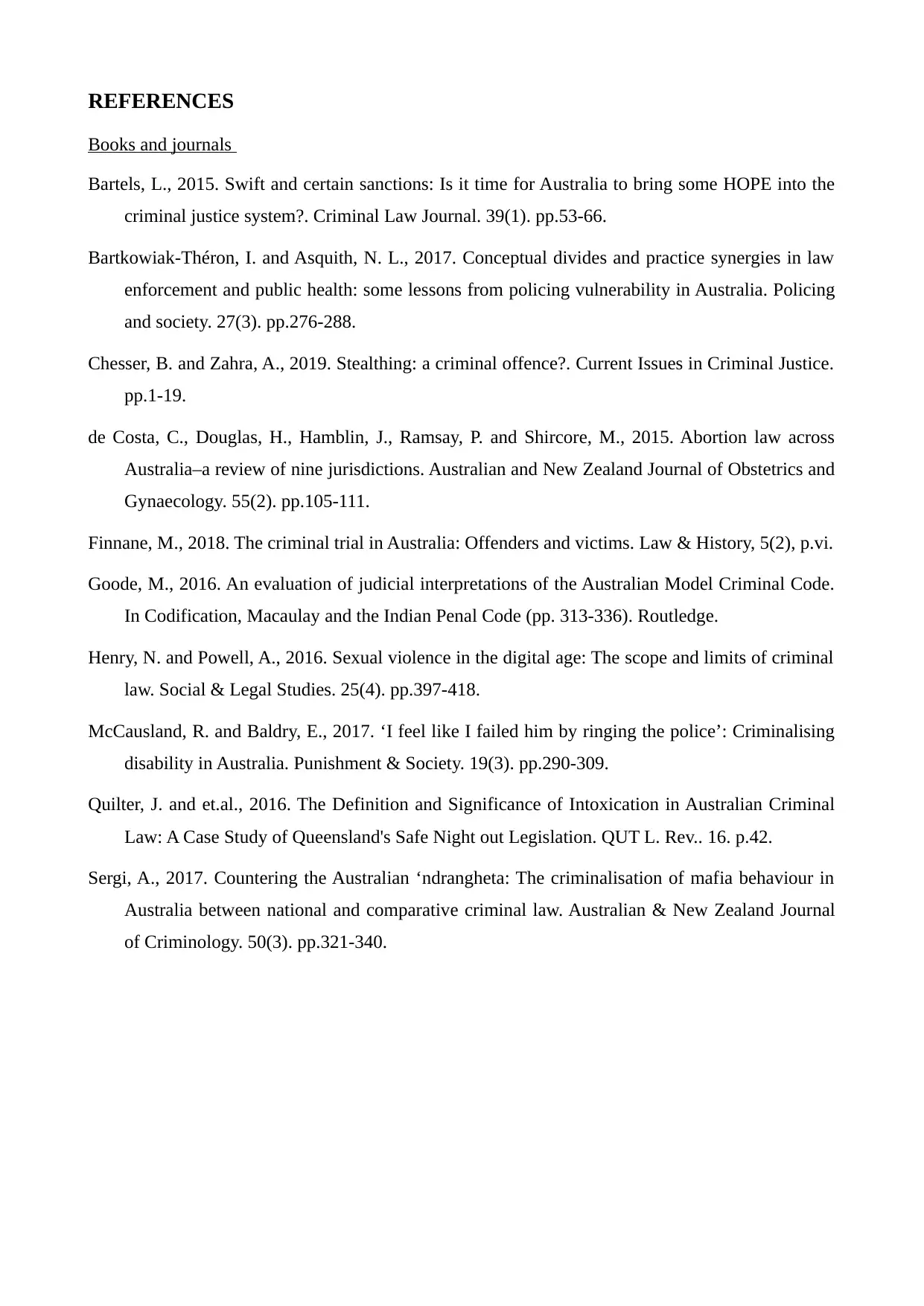
REFERENCES
Books and journals
Bartels, L., 2015. Swift and certain sanctions: Is it time for Australia to bring some HOPE into the
criminal justice system?. Criminal Law Journal. 39(1). pp.53-66.
Bartkowiak-Théron, I. and Asquith, N. L., 2017. Conceptual divides and practice synergies in law
enforcement and public health: some lessons from policing vulnerability in Australia. Policing
and society. 27(3). pp.276-288.
Chesser, B. and Zahra, A., 2019. Stealthing: a criminal offence?. Current Issues in Criminal Justice.
pp.1-19.
de Costa, C., Douglas, H., Hamblin, J., Ramsay, P. and Shircore, M., 2015. Abortion law across
Australia–a review of nine jurisdictions. Australian and New Zealand Journal of Obstetrics and
Gynaecology. 55(2). pp.105-111.
Finnane, M., 2018. The criminal trial in Australia: Offenders and victims. Law & History, 5(2), p.vi.
Goode, M., 2016. An evaluation of judicial interpretations of the Australian Model Criminal Code.
In Codification, Macaulay and the Indian Penal Code (pp. 313-336). Routledge.
Henry, N. and Powell, A., 2016. Sexual violence in the digital age: The scope and limits of criminal
law. Social & Legal Studies. 25(4). pp.397-418.
McCausland, R. and Baldry, E., 2017. ‘I feel like I failed him by ringing the police’: Criminalising
disability in Australia. Punishment & Society. 19(3). pp.290-309.
Quilter, J. and et.al., 2016. The Definition and Significance of Intoxication in Australian Criminal
Law: A Case Study of Queensland's Safe Night out Legislation. QUT L. Rev.. 16. p.42.
Sergi, A., 2017. Countering the Australian ‘ndrangheta: The criminalisation of mafia behaviour in
Australia between national and comparative criminal law. Australian & New Zealand Journal
of Criminology. 50(3). pp.321-340.
Books and journals
Bartels, L., 2015. Swift and certain sanctions: Is it time for Australia to bring some HOPE into the
criminal justice system?. Criminal Law Journal. 39(1). pp.53-66.
Bartkowiak-Théron, I. and Asquith, N. L., 2017. Conceptual divides and practice synergies in law
enforcement and public health: some lessons from policing vulnerability in Australia. Policing
and society. 27(3). pp.276-288.
Chesser, B. and Zahra, A., 2019. Stealthing: a criminal offence?. Current Issues in Criminal Justice.
pp.1-19.
de Costa, C., Douglas, H., Hamblin, J., Ramsay, P. and Shircore, M., 2015. Abortion law across
Australia–a review of nine jurisdictions. Australian and New Zealand Journal of Obstetrics and
Gynaecology. 55(2). pp.105-111.
Finnane, M., 2018. The criminal trial in Australia: Offenders and victims. Law & History, 5(2), p.vi.
Goode, M., 2016. An evaluation of judicial interpretations of the Australian Model Criminal Code.
In Codification, Macaulay and the Indian Penal Code (pp. 313-336). Routledge.
Henry, N. and Powell, A., 2016. Sexual violence in the digital age: The scope and limits of criminal
law. Social & Legal Studies. 25(4). pp.397-418.
McCausland, R. and Baldry, E., 2017. ‘I feel like I failed him by ringing the police’: Criminalising
disability in Australia. Punishment & Society. 19(3). pp.290-309.
Quilter, J. and et.al., 2016. The Definition and Significance of Intoxication in Australian Criminal
Law: A Case Study of Queensland's Safe Night out Legislation. QUT L. Rev.. 16. p.42.
Sergi, A., 2017. Countering the Australian ‘ndrangheta: The criminalisation of mafia behaviour in
Australia between national and comparative criminal law. Australian & New Zealand Journal
of Criminology. 50(3). pp.321-340.
1 out of 13
Related Documents
Your All-in-One AI-Powered Toolkit for Academic Success.
+13062052269
info@desklib.com
Available 24*7 on WhatsApp / Email
![[object Object]](/_next/static/media/star-bottom.7253800d.svg)
Unlock your academic potential
© 2024 | Zucol Services PVT LTD | All rights reserved.




